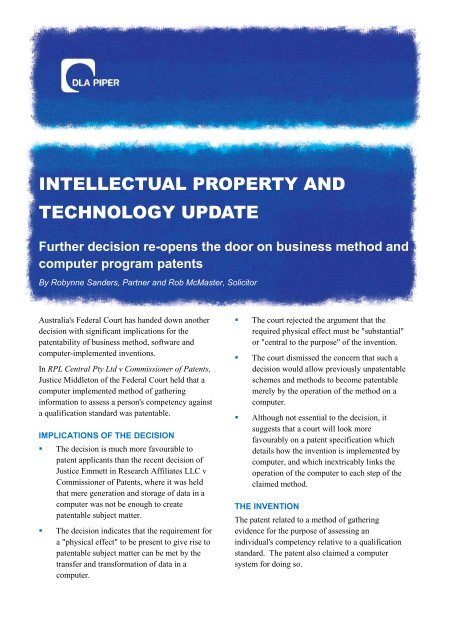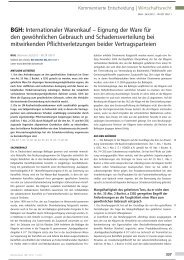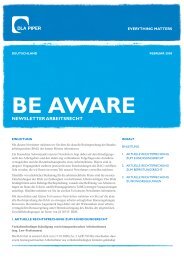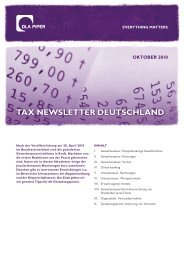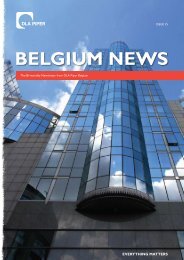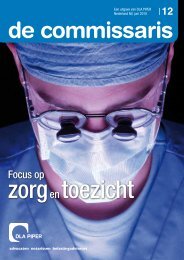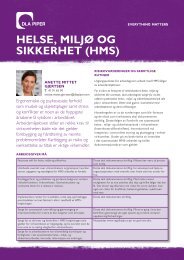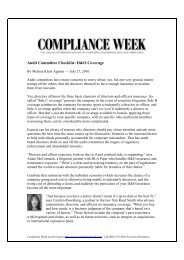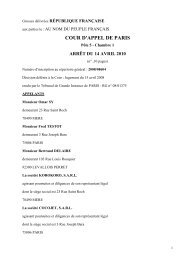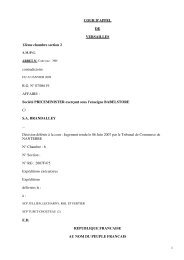Download PDF - DLA Piper
Download PDF - DLA Piper
Download PDF - DLA Piper
Create successful ePaper yourself
Turn your PDF publications into a flip-book with our unique Google optimized e-Paper software.
INTELLECTUAL PROPERTY AND<br />
TECHNOLOGY UPDATE<br />
Further decision re-opens the door on business method and<br />
computer program patents<br />
By Robynne Sanders, Partner and Rob McMaster, Solicitor<br />
Australia's Federal Court has handed down another<br />
decision with significant implications for the<br />
patentability of business method, software and<br />
computer-implemented inventions.<br />
In RPL Central Pty Ltd v Commissioner of Patents,<br />
Justice Middleton of the Federal Court held that a<br />
computer implemented method of gathering<br />
information to assess a person's competency against<br />
a qualification standard was patentable.<br />
IMPLICATIONS OF THE DECISION<br />
• The decision is much more favourable to<br />
patent applicants than the recent decision of<br />
Justice Emmett in Research Affiliates LLC v<br />
Commissioner of Patents, where it was held<br />
that mere generation and storage of data in a<br />
computer was not be enough to create<br />
patentable subject matter.<br />
• The decision indicates that the requirement for<br />
a "physical effect" to be present to give rise to<br />
patentable subject matter can be met by the<br />
transfer and transformation of data in a<br />
computer.<br />
• The court rejected the argument that the<br />
required physical effect must be "substantial"<br />
or "central to the purpose" of the invention.<br />
• The court dismissed the concern that such a<br />
decision would allow previously unpatentable<br />
schemes and methods to become patentable<br />
merely by the operation of the method on a<br />
computer.<br />
• Although not essential to the decision, it<br />
suggests that a court will look more<br />
favourably on a patent specification which<br />
details how the invention is implemented by<br />
computer, and which inextricably links the<br />
operation of the computer to each step of the<br />
claimed method.<br />
THE INVENTION<br />
The patent related to a method of gathering<br />
evidence for the purpose of assessing an<br />
individual's competency relative to a qualification<br />
standard. The patent also claimed a computer<br />
system for doing so.
• A computer retrieving from the internet a set<br />
of criteria for assessment against a<br />
qualification standard;<br />
• The computer processing the criteria to<br />
generate a set of questions to assess an<br />
individual's competence against the criteria;<br />
• An assessment server presenting the questions<br />
to the computer of the individual requiring<br />
assessment; and<br />
• Receiving responses from the individual,<br />
including attached files from their computer.<br />
The method was primarily directed at enabling<br />
individuals to assess their eligibility for a grant of<br />
Recognition of Prior Learning (RPL) from<br />
recognised training institutions.<br />
THE COURT'S DECISION<br />
In reaching its decision, the court referred to the<br />
well-established principle that for patentable<br />
subject matter to exist there must be "an artificially<br />
created state of affairs", which must have value in a<br />
field of economic endeavour. It was also noted that<br />
there was a need for a "physical effect" in the sense<br />
of a concrete effect or phenomenon or<br />
manifestation or transformation.<br />
In deciding that the invention was patentable, the<br />
court found that:<br />
• the invention had value in the field of<br />
economic endeavour as it overcame<br />
difficulties in seeking out relevant training<br />
providers and enabling the recognition of prior<br />
learning;<br />
• the involvement of the computer was<br />
described in the claims of the patent in such a<br />
way that it was "inextricably linked" to the<br />
invention;<br />
• the patent specification provided significant<br />
information as to how the invention is to be<br />
implemented by computer, including the<br />
programming of the computer that retrieves<br />
the assessment criteria and generates the<br />
questions, and the programming of the<br />
assessment server to present the data to a user;<br />
• each of the steps of the method required or<br />
involved a computer generated process, and<br />
accordingly, there were a number of physical<br />
effects which occurred in implementing the<br />
invention;<br />
• the generation of questions and presentation of<br />
these questions to a user creates "an artificially<br />
created state of affairs" in their computer (in<br />
that there is a retrieval and transfer of data into<br />
questions, and a corresponding change in state<br />
or information in a part of a machine); and<br />
• there was no requirement that the "physical<br />
effect" produced be substantial or central to<br />
the invention.<br />
The Commissioner of Patents had submitted that if<br />
the "physical effect" requirement could be satisfied<br />
merely by operation of a method on a computer,<br />
then many previously patentable schemes and<br />
methods would become patentable subject matter.<br />
Justice Middleton agreed with previous decisions<br />
that this was not a valid objection, and that each<br />
case must be assessed on its own merits in light of<br />
the relevant circumstances.<br />
Many aspects of this decisions sit very<br />
uncomfortable with the Federal Court's decision in<br />
Research Affiliates LLC v Commissioner of Patents,<br />
handed down in February this year. Our update on<br />
this decision can be found here. In Research<br />
Affiliates, Justice Emmett held that a computerimplemented<br />
method of generating an index for<br />
weighting an investment portfolio was not<br />
patentable on the basis that the generation of<br />
computer file containing the index did not create<br />
"an artificially created state of affairs" as the index<br />
was mere data.<br />
The hearing in RPL Central Pty Ltd v<br />
Commissioner of Patents was held before the<br />
decision in Research Affiliates was handed down.<br />
In the closing paragraphs of RPL Central, Justice<br />
Middleton comments on Justice Emmett's decision<br />
in Research Affiliates. Justice Middleton points out<br />
that Justice Emmett appeared to be influenced by<br />
two factors:<br />
• the same concern expressed by the<br />
Commissioner of patents in RPL Central, that<br />
is, that if the mere operation of a method by<br />
computer created patentable subject matter,<br />
any computer-implemented scheme would<br />
become patentable merely by reason of being<br />
implemented on a computer; and<br />
<strong>DLA</strong> <strong>Piper</strong> 2
• the patent specifications in Research Affiliates<br />
contained virtually no substantive detail about<br />
how the method was to be implemented by a<br />
computer.<br />
Justice Middleton distinguishes RPL Central from<br />
Research Affiliates on the basis that the<br />
specification in RPL Central provides significant<br />
information about how the invention is to be<br />
implemented. However, this distinction does not<br />
seem to have influenced Justice Middleton's<br />
ultimate conclusion in any way, as this was based<br />
on the finding that the transfer and transformation<br />
of data in a computer provided the required<br />
"physical effect". Therefore the underlying<br />
reasoning of the two decisions seems to be<br />
contrary, and significant uncertainty still remains.<br />
THE FUTURE<br />
The decision in Research Affiliates is currently<br />
under appeal to the Full Federal Court. A decision<br />
of the Full Federal Court will give more guidance<br />
on the patentability of computer implemented<br />
methods. It remains to be seen whether the<br />
decisions in RPL Central will also be appealed.<br />
MORE INFORMATION<br />
For more information, please contact:<br />
Robynne Sanders<br />
Partner<br />
T +61 3 9274 5539<br />
robynne.sanders@dlapiper.com<br />
Contact your nearest <strong>DLA</strong> <strong>Piper</strong> office:<br />
BRISBANE<br />
Level 29, Waterfront Place<br />
1 Eagle Street<br />
Brisbane QLD 4000<br />
T +61 7 3246 4000<br />
F +61 7 3229 4077<br />
brisbane@dlapiper.com<br />
CANBERRA<br />
Level 3, 55 Wentworth Avenue<br />
Kingston ACT 2604<br />
T +61 2 6201 8787<br />
F +61 2 6230 7848<br />
canberra@dlapiper.com<br />
MELBOURNE<br />
Level 21, 140 William Street<br />
Melbourne VIC 3000<br />
T +61 3 9274 5000<br />
F +61 3 9274 5111<br />
melbourne@dlapiper.com<br />
PERTH<br />
Level 31, Central Park<br />
152–158 St Georges Terrace<br />
Perth WA 6000<br />
T +61 8 6467 6000<br />
F +61 8 6467 6001<br />
perth@dlapiper.com<br />
SYDNEY<br />
Level 38, 201 Elizabeth Street<br />
Sydney NSW 2000<br />
T +61 2 9286 8000<br />
F +61 2 9286 4144<br />
sydney@dlapiper.com<br />
www.dlapiper.com<br />
<strong>DLA</strong> <strong>Piper</strong> is a global law firm operating through various<br />
separate and distinct legal entities.<br />
For further information, please refer to www.dlapiper.com<br />
Copyright © 2013 <strong>DLA</strong> <strong>Piper</strong>. All rights reserved.<br />
1201558350/JPS/082013<br />
Rob McMaster<br />
Solicitor<br />
T +61 3 9274 5648<br />
rob.mcmaster@dlapiper.com<br />
<strong>DLA</strong> <strong>Piper</strong> 3


